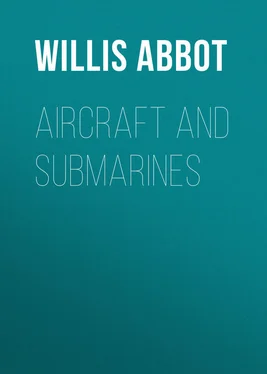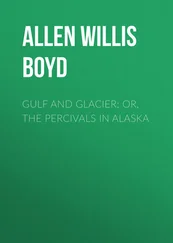Willis Abbot - Aircraft and Submarines
Здесь есть возможность читать онлайн «Willis Abbot - Aircraft and Submarines» — ознакомительный отрывок электронной книги совершенно бесплатно, а после прочтения отрывка купить полную версию. В некоторых случаях можно слушать аудио, скачать через торрент в формате fb2 и присутствует краткое содержание. Жанр: foreign_antique, foreign_prose, на английском языке. Описание произведения, (предисловие) а так же отзывы посетителей доступны на портале библиотеки ЛибКат.
- Название:Aircraft and Submarines
- Автор:
- Жанр:
- Год:неизвестен
- ISBN:нет данных
- Рейтинг книги:4 / 5. Голосов: 1
-
Избранное:Добавить в избранное
- Отзывы:
-
Ваша оценка:
- 80
- 1
- 2
- 3
- 4
- 5
Aircraft and Submarines: краткое содержание, описание и аннотация
Предлагаем к чтению аннотацию, описание, краткое содержание или предисловие (зависит от того, что написал сам автор книги «Aircraft and Submarines»). Если вы не нашли необходимую информацию о книге — напишите в комментариях, мы постараемся отыскать её.
Aircraft and Submarines — читать онлайн ознакомительный отрывок
Ниже представлен текст книги, разбитый по страницам. Система сохранения места последней прочитанной страницы, позволяет с удобством читать онлайн бесплатно книгу «Aircraft and Submarines», без необходимости каждый раз заново искать на чём Вы остановились. Поставьте закладку, и сможете в любой момент перейти на страницу, на которой закончили чтение.
Интервал:
Закладка:
The bird should with the aid of the wind raise itself to a great height, and this will be its safety; because although the revolutions mentioned may happen there is time for it to recover its equilibrium, provided its various parts are capable of strong resistance so that they may safely withstand the fury and impetus of the descent.
The fallacy that a man could, by the rapid flapping of wings of any sort, overcome the force of gravity persisted up to a very recent day, despite the complete mathematical demonstration by von Helmholtz in 1878 that man could not possibly by his own muscular exertions raise his own weight into the air and keep it suspended. Time after time the "flapping wings" were resorted to by ambitious aviators with results akin to those attained by Darius Green. One of the earliest was a French locksmith named Besnier, who had four collapsible planes on two rods balanced across his shoulders. These he vigorously moved up and down with his hands and feet, the planes opening like covers of a book as they came down, and closing as they came up. Besnier made no attempt to raise himself from the ground, but believed that once launched in the air from an elevation he could maintain himself, and glide gradually to earth at a considerable distance. It is said that he and one or two of his students did in a way accomplish this. Others, however, experimenting with the same method came to sorry disaster. Among these was an Italian friar whom King James IV. of Scotland had made Prior of Tongland. Equipped with a pair of large feather wings operated on the Besnier principle, he launched himself from the battlements of Stirling Castle in the presence of King James and his court. But gravity was too much for his apparatus, and turning over and over in mid-air he finally landed ingloriously on a manure heap – at that period of nascent culture a very common feature of the pleasure grounds of a palace. He had a soul above his fate however, for he ascribed his fall not to vulgar mechanical causes, but wholly to the fact that he had overlooked the proper dignity of flight by pluming his wings with the feathers of common barn-yard fowl instead of with plumes plucked from the wings of eagles!
In sharp competition with the aspiring souls who sought to fly with wings – the forerunners of the airplane devotees of to-day – were those who tried to find some direct lifting device for a car which should contain the aviators. Some of their ideas were curiously logical and at the same time comic. There was, for example, a priest, Le Père Galien of Avignon. He observed that the rarified air at the summit of the Alps was vastly lighter than that in the valleys below. What then was to hinder carrying up empty sacks of cotton or oiled silk to the mountain tops, opening them to the lighter air of the upper ranges, and sealing them hermetically when filled by it. When brought down into the valleys they would have lifting power enough to carry tons up to the summits again. The good Father's education in physics was not sufficiently advanced to warn him that the effort to drag the balloons down into the valley would exact precisely the force they would exert in lifting any load out of the valley – if indeed they possessed any lifting power whatsoever, which is exceedingly doubtful.
Another project, which sounded logical enough, was based on the irrefutable truth that as air has some weight – to be exact 14.70 pounds for a column one inch square and the height of the earth's atmosphere – a vacuum must be lighter, as it contains nothing, not even air. Accordingly in the seventeenth century, one Francisco Lana, another priest, proposed to build an airship supported by four globes of copper, very thin and light, from which all the air had been pumped. The globes were to be twenty feet in diameter, and were estimated to have a lifting force of 2650 pounds. The weight of the copper shells was put at 1030 pounds, leaving a margin of possible weight for the car and its contents of 1620 pounds. It seemed at first glance a perfectly reasonable and logical plan. Unhappily one factor in the problem had been ignored. The atmospheric pressure on each of the globes would be about 1800 tons. Something more than a thin copper shell would be needed to resist this crushing force and an adequate increase in the strength of the shells would so enhance their weight as to destroy their lifting power.
To tell at length the stories of attempt and failure of the earliest dabblers in aeronautics would be unprofitable and uninteresting. Not until the eighteenth century did the experimenters with lighter-than-air devices show any practical results. Not until the twentieth century did the advocates of the heavier-than-air machines show the value of their fundamental idea. The former had to discover a gaseous substance actually lighter, and much lighter, than the surrounding atmosphere before they could make headway. The latter were compelled to abandon wholly the effort to imitate the flapping of a bird's wings, and study rather the method by which the bird adjusts the surface of its wings to the wind and soars without apparent effort, before they could show the world any promising results.
Nearly every step forward in applied science is accomplished because of the observation by some thoughtful mind of some common phenomenon of nature, and the later application of those observations to some useful purpose.
It seems a far cry from an ancient Greek philosopher reposing peacefully in his bath to a modern Zeppelin, but the connection is direct. Every schoolboy knows the story of the sudden dash of Archimedes, stark and dripping from his tub, with the triumphant cry of "Eureka!" – "I have found it!" What he had found was the rule which governed the partial flotation of his body in water. Most of us observe it, but the philosophical mind alone inquired "Why?" Archimedes' answer was this rule which has become a fundamental of physics: "A body plunged into a fluid is subjected by this fluid to a pressure from below to above equal to the weight of the fluid displaced by the body." A balloon is plunged in the air – a fluid. If it is filled with air there is no upward pressure from below, but if it is filled with a gas lighter than air there is a pressure upward equal to the difference between the weight of that gas and that of an equal quantity of air. Upon that fact rests the whole theory and practice of ballooning.
The illustration of James Watt watching the steam rattle the cover of a teapot and from it getting the rudimentary idea of the steam engine is another case in point. Sometimes however the application of the hints of nature to the needs of man is rather ludicrously indirect. Charles Lamb gravely averred that because an early Chinaman discovered that the flesh of a pet pig, accidentally roasted in the destruction by fire of his owner's house, proved delicious to the palate, the Chinese for years made a practice of burning down their houses to get roast pig with "crackling." Early experimenters in aviation observed that birds flapped their wings and flew. Accordingly they believed that man to fly must have wings and flap them likewise. Not for hundreds of years did they observe that most birds flapped their wings only to get headway, or altitude, thereafter soaring to great heights and distances merely by adjusting the angle of their wings to the various currents of air they encountered.
In a similar way the earliest experimenters with balloons observed that smoke always ascended. "Let us fill a light envelope with smoke," said they, "and it will rise into the air bearing a burden with it." All of which was true enough, and some of the first balloonists cast upon their fires substances like sulphur and pitch in order to produce a thicker smoke, which they believed had greater lifting power than ordinary hot air.
In the race for actual accomplishment the balloonists, the advocates of lighter-than-air machines, took the lead at first. It is customary and reasonable to discard as fanciful the various devices and theories put forward by the experimenters in the Middle Ages and fix the beginning of practical aeronautical devices with the invention of hot-air balloons by the Montgolfiers, of Paris, in 1783.
Читать дальшеИнтервал:
Закладка:
Похожие книги на «Aircraft and Submarines»
Представляем Вашему вниманию похожие книги на «Aircraft and Submarines» списком для выбора. Мы отобрали схожую по названию и смыслу литературу в надежде предоставить читателям больше вариантов отыскать новые, интересные, ещё непрочитанные произведения.
Обсуждение, отзывы о книге «Aircraft and Submarines» и просто собственные мнения читателей. Оставьте ваши комментарии, напишите, что Вы думаете о произведении, его смысле или главных героях. Укажите что конкретно понравилось, а что нет, и почему Вы так считаете.












